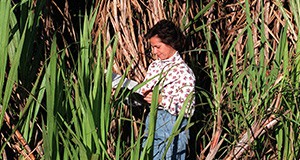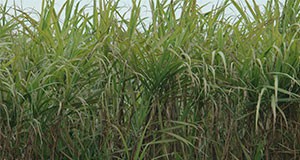
Sands used in sugarcane production in Florida have low levels of organic matter, silt, and clay, and they provide little N through mineralization of organic matter and possess a low capacity for N retention as a result. Because these soils are highly leachable, N must be managed well to ensure adequate nutrition for the crop as well as protection of groundwater. This new 4-page fact sheet is part of the Sugarcane Handbook, and it discusses sand soils used in sugarcane production, sugar yield response to nitrogen, and revised nitrogen recommendations. Written by J. Mabry McCray, Kelly T. Morgan, and Les Baucum, and published by the UF Agronomy Department, February 2016.
http://edis.ifas.ufl.edu/sc101
Tag: Leslie E. Baucum
Effects of Harvest Method on Microclimate in Florida Sugarcane
 The production systems for sugarcane include either green cane or burnt cane harvesting operations. Sugarcane in Florida is typically harvested with burnt cane mechanical harvesting, but there is a growing interest to better understand the effects of green cane harvest residue “trash blankets” on microclimate conditions for sugarcane growing on both organic and mineral soils of Florida, so the authors conducted a three-year study to determine the effects of each harvest method on microclimate within the surface soil profile and at a 10 cm height from the soil surface. Results are presented in this 4-page fact sheet written by Hardev Sandhu, Maninder Singh, Robert Gilbert, Kelly Morgan, Ronald Rice, Leslie Baucum, James Shine Jr., and Mike Irey, and published by the UF Department of Agronomy, April 2015. (UF/IFAS Photo: Josh Wickham.)
The production systems for sugarcane include either green cane or burnt cane harvesting operations. Sugarcane in Florida is typically harvested with burnt cane mechanical harvesting, but there is a growing interest to better understand the effects of green cane harvest residue “trash blankets” on microclimate conditions for sugarcane growing on both organic and mineral soils of Florida, so the authors conducted a three-year study to determine the effects of each harvest method on microclimate within the surface soil profile and at a 10 cm height from the soil surface. Results are presented in this 4-page fact sheet written by Hardev Sandhu, Maninder Singh, Robert Gilbert, Kelly Morgan, Ronald Rice, Leslie Baucum, James Shine Jr., and Mike Irey, and published by the UF Department of Agronomy, April 2015. (UF/IFAS Photo: Josh Wickham.)
http://edis.ifas.ufl.edu/sc100
SC087 Projected Costs and Returns for Sugarcane Production on Mineral Soils of South Florida, 2007-2008
SC087, a 16-page report by Fritz M. Roka, Jose Alvarez, and Leslie E. Baucum, develops a model enterprise budget that reflects annual costs and returns for a 5,000-acre farm that grows sugarcane on mineral soils. Includes references. Published by the UF Department of Agronomy, September 2009.
http://edis.ifas.ufl.edu/SC087
SSAGR253/SC052 Backyard Sugarcane
Revised! SS-AGR-253, a 5-page fact sheet by L. Baucum, R.W. Rice, and L. Muralles, informs homeowners of the types and varieties of sugarcane, site selection, planting material, planting, early care, formation of the stool, pest management, harvesting, and overwintering. Published by the UF Department of Agronomy, October 2009.
http://edis.ifas.ufl.edu/SC052
SL295/SS508 Review of Current Sugarcane Fertilizer Recommendations: A Report from the UF/IFAS Sugarcane Fertilizer Standards Task Force
SL-295, a 6-page report by K.T. Morgan, J.M. McCray, R.W. Rice, R.A. Gilbert and L.E. Baucum, reports the findings of a task force of Florida agronomists and soil scientists, agents and local grower representatives. It includes a review of the current fertilizer recommendations for sugarcane, a review of recent sugarcane fertilizer research, and an assessment of the gaps and recommended research priorities. Published by the UF Department of Soil and Water Science, July 2009.
http://edis.ifas.ufl.edu/SS508
SS-AGR-332/SC032 An Overview of Florida Sugarcane
Revised! SS-AGR-232, an 8-page illustrated fact sheet by L. E. Baucum and R. W. Rice, answers the most frequently asked questions about the commercial Florida sugarcane industry and describes the production of sugarcane and sugar. Published by the UF Department of Agronomy, August 2009.
http://edis.ifas.ufl.edu/SC032